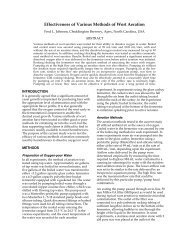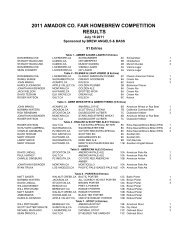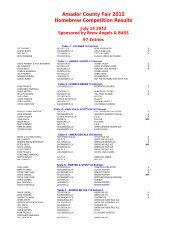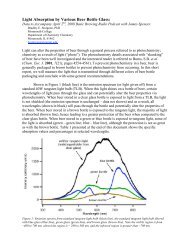A Homebrewer's Guide to Beer Flavor Descriptors - Brew Angels
A Homebrewer's Guide to Beer Flavor Descriptors - Brew Angels
A Homebrewer's Guide to Beer Flavor Descriptors - Brew Angels
You also want an ePaper? Increase the reach of your titles
YUMPU automatically turns print PDFs into web optimized ePapers that Google loves.
tartness that is unpleasant. It is mouth‐puckering,<br />
dry, membrane‐contracting sensation. It may be<br />
strongly tannic, vinegarish or intensely tart. Unripe<br />
fruit and chewed grape skins give astringent<br />
reactions. The intensely acidic taste can be experienced<br />
by any brewer willing <strong>to</strong> sample the trub<br />
scum thrown up by a kraeusen fermentation head.<br />
Bacterial contamination of the fermentation<br />
or aging beer can cause astringency, usually with<br />
the vinegar flavor indicative of acetic‐acid bacte‐<br />
rial activity, or a fruity odor. Lactic‐acid bacteria<br />
that are the cause generally form a detectable<br />
rancid‐butter diacetyl smell. Contaminant‐originated<br />
sourness is usually distinguishable by accompanying<br />
off‐flavors or odors.<br />
More commonly, astringency is a symp<strong>to</strong>m of<br />
ill‐considered formulation or processing. Worts<br />
that lack unfermentable sugars have no balancing<br />
maltiness or sweetness <strong>to</strong> mask astringency.<br />
When astringency is from the hops, it is always<br />
more noticeable in pale, dry beers than in richer,<br />
sweeter types. Excessive hopping will always give<br />
polyphenolic‐anthocyanogenic astringency in<br />
overattenuated brews.<br />
Poor separation of the trub from any fermenting<br />
beer should be suspect whenever astringency is<br />
encountered. The brown scum thrown up during<br />
vigorous fermentation is largely composed of intensely<br />
bitter phenolic hop and malt‐husk residues.<br />
These may be reabsorbed by the fermenting<br />
beer if they are not in some manner separated from<br />
it. Separation may be done by simply letting it<br />
stick <strong>to</strong> the <strong>to</strong>p of an oversized fermenter, or by<br />
removing it by skimming, or “blowing off.”<br />
Dry, husky bitterness in grain‐brewed beers is<br />
usually the result of overzealous crushing. Torn,<br />
shredded husks cause melanoidin and phenolic<br />
astringency. Less readily pinpointed astringency<br />
may be caused by alkaline mash or sparge water,<br />
or very excessive sparging. Again, very dry, lingering<br />
astringency on the roof of the mouth and in the<br />
throat suggests this source.<br />
Where astringency is encountered, review the<br />
beer’s flavor profile and its brewing. If it seems <strong>to</strong><br />
originate by a faulty process, use accompanying<br />
clues <strong>to</strong> determine its origin.<br />
Carbonation<br />
By Grosvenor Merle‐Smith<br />
Carbonation is literally the breath of life, for a<br />
flat beer is a dead beer. Visually our drink becomes<br />
more exciting with bubbles trailing up through the<br />
beer <strong>to</strong> the surface, forming a luscious creamy<br />
head. Raising the glass, we find that this release<br />
of carbon dioxide carries with it a barrage of volatile<br />
aromatics. Even before tasting we are given an<br />
exciting preview of what is <strong>to</strong> come. Now in the<br />
mouth, bubbles titillate the palate, enhancing the<br />
flavor sensation and making the experience more<br />
refreshing.<br />
<strong>Beer</strong> is somewhat carbonated after a normal<br />
non‐pressurized fermentation. As homebrewers<br />
usually we wait, allowing the beer <strong>to</strong> go flat,<br />
ensuring a consistent point at which we can add a<br />
certain amount of ingredients <strong>to</strong> result in carbonation.<br />
Before kegging or bottling, the brew is primed<br />
with more fermentable sugars creating a carbonation<br />
pressure in the final product of approximately<br />
2 1/2 atmospheres.<br />
In serving, we would like the beer, once the<br />
initial excess pressure is released, <strong>to</strong> lose the CO₂<br />
at a slow rate, creating a sparkle in the body while<br />
maintaining an appropriate head. There are a<br />
number of fac<strong>to</strong>rs involved in accomplishing this.<br />
First, let’s make the assumption that the beer has<br />
been primed with the correct amount of sugars <strong>to</strong><br />
give the desired carbonation initially. Obviously,<br />
<strong>to</strong>o little will result in a flat product, while <strong>to</strong>o<br />
much results in overcarbonation.<br />
When a beer is tapped or opened, the ambient<br />
pressure is lowered and the CO₂ starts <strong>to</strong> come out<br />
of solution. Bubbles form and rise <strong>to</strong> the surface,<br />
36 SPECIAL ISSUE 1987 ZYMURGY






